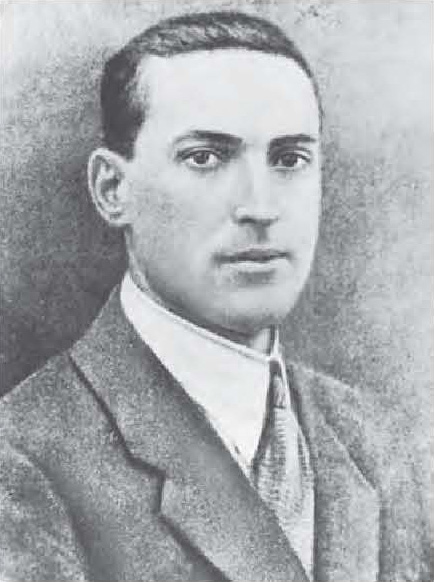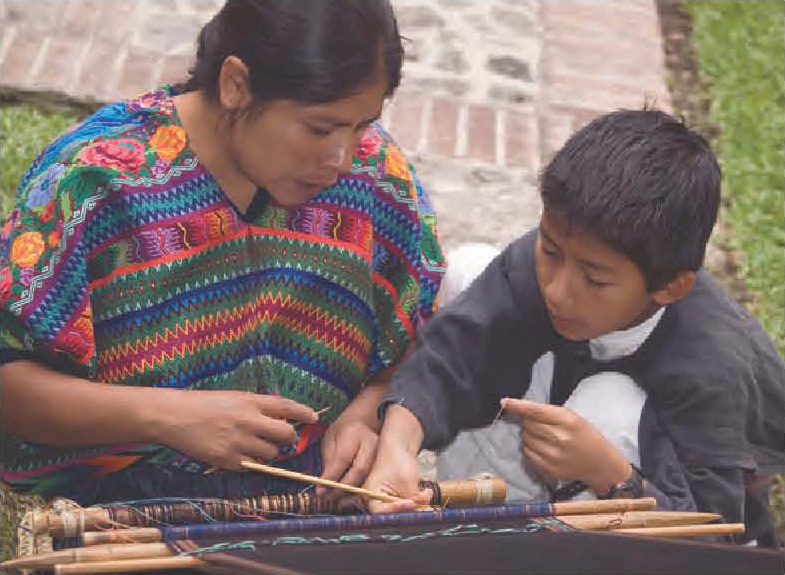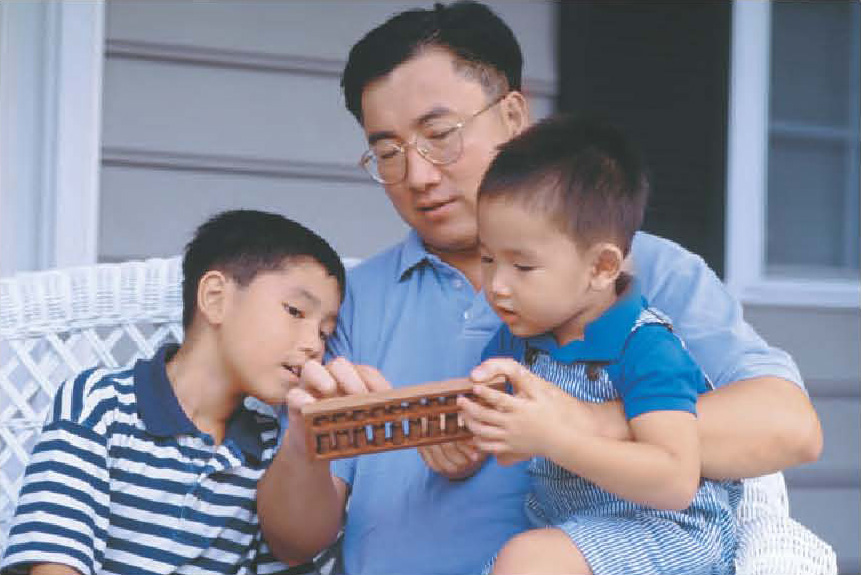Sociocultural Theories
A mother and her 4-year-old daughter, Sadie, assemble a toy, using a diagram to guide them:
- Mother: Now you need another one like this on the other side. Mmmmm…there you go, just like that.
- Sadie: Then I need this one to go like this? Hold on, hold on. Let it go. There. Get that out. Oops.
- M: I’ll hold it while you turn it. (Watches Sadie work on toy) Now you make the end.
- S: This one?
- M: No, look at the picture. Right here (points to diagram). That piece.
- S: Like this?
- M: Yeah.
(Gauvain, 2001, p. 32)
sociocultural theories  approaches that emphasize that other people and the surrounding culture contribute greatly to children’s development
approaches that emphasize that other people and the surrounding culture contribute greatly to children’s development
This interaction probably strikes you as completely unexceptional—and it is. From the perspective of sociocultural theories, however, it and thousands of other everyday interactions like it are of the utmost importance, because they are the engines of development.
One noteworthy characteristic of the event, from the sociocultural perspective, is that Sadie is learning to assemble the toy in an interpersonal context. Sociocultural theorists emphasize that much of cognitive development takes place through direct interactions between children and other people—parents, siblings, teachers, playmates, and so on—who want to help children acquire the skills and knowledge valued by their culture. Thus, whereas Piagetian and information-processing theories emphasize children’s own efforts to understand the world, sociocultural theories emphasize the developmental importance of children’s interactions with other people.

guided participation  a process in which more knowledgeable individuals organize activities in ways that allow less knowledgeable people to learn
a process in which more knowledgeable individuals organize activities in ways that allow less knowledgeable people to learn
The interaction between Sadie and her mother is also noteworthy because it exemplifies guided participation, a process in which more knowledgeable individuals organize activities in ways that allow less knowledgeable people to engage in them at a higher level than they could manage on their own (Rogoff, 2003). Sadie’s mother, for example, holds one part of the toy so that Sadie can screw in another part. On her own, Sadie would be unable to screw the two parts together and therefore could not improve her skill at the task. Similarly, Sadie’s mother points to the relevant part of the diagram, enabling Sadie to decide what to do next and also to learn how diagrams convey information. As this episode illustrates, guided participation often occurs in situations in which the explicit purpose is to achieve a practical goal, such as assembling a toy, but in which learning occurs as a by-product of the goal-directed activity.
156
cultural tools  the innumerable products of human ingenuity that enhance thinking
the innumerable products of human ingenuity that enhance thinking
A third noteworthy characteristic of the interaction between Sadie and her mother is that it occurs in a broader cultural context. This context includes not only other people but also the innumerable products of human ingenuity that sociocultural theorists refer to as cultural tools: symbol systems, artifacts, skills, values, and so on. In the example of Sadie and her mother, the relevant symbol systems include the language they use to convey their thoughts and the diagram they use to guide their assembly efforts; the relevant artifacts include the toy and the printed sheet on which the diagram appears; the relevant skills include the proficiency in language that allows them to communicate with each other and the procedures they use to interpret the diagram; and the values include the culture’s approval of parents interacting with their children in the way that Sadie’s mother does and of young girls’ learning mechanical skills. In the background are an array of broader technological, economic, and historical factors: the technology needed to manufacture toys and print diagrams, for example; an economy that allows parents the leisure time for such interactions; and a history leading up to the symbol systems, artifacts, skills, and values reflected in the interactions between Sadie and her mother. Thus, sociocultural theories can help us appreciate the many aspects of culture embodied in even the smallest everyday interactions.
View of Children’s Nature
The giant of the sociocultural approach to cognitive development, and in many ways its originator, was the Russian psychologist Lev Semyonovich Vygotsky. Although Vygotsky and Piaget were contemporaries, much of Vygotsky’s most important work was largely unknown outside Russia until the 1970s. Its appearance created a stir, in part because Vygotsky’s view of children’s nature was so different from Piaget’s.
Vygotsky’s Theory

As noted earlier, Piaget depicted children as little scientists, trying to understand the world on their own. Vygotsky, in contrast, portrayed them as social learners, intertwined with other people who are eager to help them gain skills and understanding. Whereas Piaget viewed children as intent on mastering physical, mathematical, and logical concepts that are the same in all times and places, Vygotsky viewed them as intent on participating in activities that happen to be prevalent in their local setting. Whereas Piaget emphasized qualitative changes in thinking, Vygotsky emphasized continuous, quantitative changes. These Vygotskian views gave rise to the central metaphor of sociocultural theories: children as social learners, shaped by, and shaping, their cultural contexts.
157
Vygotsky’s emphasis on children as social learners is evident in his perspective on the relation between language and thought. Whereas Piaget viewed the two as largely unrelated, Vygotsky (1934/1962) viewed them as integrally related. In particular, he believed that thought is internalized speech and that thought originates in large part in statements that parents and other adults make to children.
private speech  the second phase of Vygotsky’s internalization-of-thought process, in which children develop their self-regulation and problem-solving abilities by telling themselves aloud what to do, much as their parents did in the first stage
the second phase of Vygotsky’s internalization-of-thought process, in which children develop their self-regulation and problem-solving abilities by telling themselves aloud what to do, much as their parents did in the first stage
To illustrate the process of internalizing speech, Vygotsky described three phases of its role in the development of children’s ability to regulate their own behavior and problem solving. At first, children’s behavior is controlled by other people’s statements (as in the example of Sadie and her mother assembling the toy); then, children’s behavior is controlled by their own private speech, in which they tell themselves aloud what to do, much as their parents might have done earlier; and then, their behavior is controlled by internalized private speech (thought), in which they silently tell themselves what to do. The transition between the second and third phases often involves whispers or silent lip movements; in Vygotsky’s terms, the speech “goes underground” and becomes thought.
Private speech is most prevalent between ages 4 and 6 years, although older children and adults also use it on challenging tasks, such as assembling model airplanes or following complex directions (Winsler et al., 2003). In addition, the progression from external to internalized speech emerges not only with age but also with experience; children generate a considerable amount of overt private speech when they first encounter a challenging task, but the amount lessens as they master it (Berk, 1994).
Children as Teachers and Learners

Contemporary sociocultural theorists, such as Michael Tomasello (2001; 2009), have extended Vygotsky’s insights. Tomasello proposed that the human species has two unique characteristics that are crucial to the ability to create complex, rapidly changing cultures. One of these is the inclination to teach others of the species; the other is the inclination to attend to and learn from such teaching. In every human society, adults communicate facts, skills, values, and traditions to their young. This is what makes culture possible; as Isaac Newton noted, it enables the new generation to stand on the shoulders of the old and thus to see farther. The inclination to teach emerges very early: all normal 2-year-olds spontaneously point to and name objects to call other people’s attention to what they themselves find interesting. Only humans engage in such rudimentary teaching behaviors that are not directly tied to survival. This inclination to teach and to learn from teaching is what enables children to be socialized into their culture and to pass that culture on to others.
Children as Products of Their Culture
Sociocultural theorists believe that many of the processes that produce development, such as guided participation, are the same in all societies. However, the content that children learn—the particular symbol systems, artifacts, skills, and values—vary greatly from culture to culture and shape thinking accordingly.
158

One example of the impact of culturally specific content comes from a study of analogical reasoning, a process in which experience with previously encountered problems is applied to new problems. In the study (Chen, Mo, & Honomichl, 2004), American and Chinese college students were asked to solve two problems. One problem required a solution analogous to the strategy of leaving a trail of white pebbles to follow home from the woods in “Hansel and Gretel,” a tale well known to the American students but unknown to the Chinese. The American students were far more successful in solving that problem, and many of them alluded to the fairy tale even though they had not heard it in many years. The other problem required a solution analogous to that in a fairy tale that was well known to the Chinese students but unknown to the Americans. In this case, the Chinese students were vastly superior in solving the problem, and many alluded to the relevant fairy tale.
Children’s memories of their own experiences also reflect their culture. When 4- to 8-year-olds from China and the United States were asked to describe their earliest memories, their descriptions differed in ways that reflected their culture’s attitudes and values (Wang, 2007). Chinese culture prizes and promotes interdependence among people, especially among close relatives. European American culture, in contrast, prizes and promotes the independence of individuals. Consistent with these cultural emphases, the Chinese children’s reports of their earliest memories included more references to other people than did those of American children, and the American children’s reports included more references to the child’s own feelings and reactions. Thus, the attitudes and values of a culture, as well as its artifacts and technologies, shape the thoughts and memories of people in that culture.
Central Developmental Issues
Vygotsky and contemporary sociocultural theorists have proposed a number of specific ideas about how change occurs through social interaction. One of these ideas—guided participation—has already been discussed. In this section, we examine two related concepts that play prominent roles in sociocultural analyses of change: intersubjectivity and social scaffolding.
159
Intersubjectivity
intersubjectivity  the mutual understanding that people share during communication
the mutual understanding that people share during communication
Sociocultural theorists believe that the foundation of human cognitive development is our ability to establish intersubjectivity, the mutual understanding that people share during communication (Gauvain, 2001; Rommetveit, 1985). The idea behind this imposing term is both simple and profound: effective communication requires participants to focus on the same topic, and also on each other’s reaction to whatever is being communicated. Such a “meeting of the minds” is indispensable for effective teaching and learning.
The roots of intersubjectivity are evident early in infancy. By age 6 months, infants can learn novel behaviors by observing another person’s behavior, which requires attending to the same actions as the person executing the actions (Collie & Hayne, 1999).
joint attention  a process in which social partners intentionally focus on a common referent in the external environment
a process in which social partners intentionally focus on a common referent in the external environment
This and related developments in early infancy set the stage for the emergence of a process that is at the heart of intersubjectivity—joint attention. In this process, infants and their social partners intentionally focus on a common referent in the external environment. The emergence of joint attention is evident in numerous ways. Around their first birthday, infants increasingly look toward objects that are the targets of their social partners’ gaze, even if the partner is not acting on the objects, and actively direct a partner’s attention toward objects that they themselves find interesting (Adamson, Bakeman, & Deckner, 2004; Akhtar & Gernsbacher, 2008; Moore, 2008).
Joint attention greatly increases children’s ability to learn from other people. One important example involves language learning. When an adult tells a toddler the name of an object, the adult usually looks or points directly at it; children who are looking at the same object are in a better position to learn what the word means than ones who are not (Baldwin, 1991). Indeed, the degree of success infants have in following other people’s gaze predicts their later vocabulary development (Brooks & Meltzoff, 2008) and their subsequent language development more generally (Carpenter, Nagell, & Tomasello, 1998).
Intersubjectivity continues to develop well beyond infancy, as children become increasingly able to take the perspectives of other people. For example, 4-year-olds are more likely than 3-year-olds to reach agreement with peers on the rules of a game they are about to play and the roles that each child will assume in the game (Göncü, 1993). The continuing development of such perspective-taking abilities also leads to school-aged children’s increasing ability to teach and learn from one another (Gauvain, 2001).
Social Scaffolding
social scaffolding  a process in which more competent people provide a temporary framework that supports children’s thinking at a higher level than children could manage on their own
a process in which more competent people provide a temporary framework that supports children’s thinking at a higher level than children could manage on their own
When putting up tall buildings, construction workers use metal frameworks called scaffolds, which allow them to work high above the ground. Once a building’s main structure is in place, it can support further work on its own, thus allowing the scaffolding to be removed. In an analogous fashion, children’s learning is aided by social scaffolding, in which more competent people provide a temporary framework that supports children’s thinking at a higher level than children could manage on their own (Wood, Bruner, & Ross, 1976). Ideally, supplying this framework includes explaining the goal of the task, demonstrating how the task can be done, and helping the child with the most difficult parts of the task. This, in fact, is the way parents tend to teach their children (Pratt et al., 1988; Saxe, Guberman, & Gearhart, 1987; Wood, 1986).
160

Through the process of social scaffolding, children become capable of working at a higher level than if they had not received such help. At first, this higher-level functioning requires extensive support, then it requires less and less support, and eventually it becomes possible without any support. The higher the quality of the scaffolding—that is, the more that instructional efforts are directed at the upper end of the child’s capabilities—the greater the learning (Conner, Knight, & Cross, 1997; Gauvain, 2001). The goal of social scaffolding—to allow children to learn by doing—is the same as that of guided participation, but scaffolding tends to involve more explicit instruction and explanation, whereas guided participation tends to involve adults’ organizing tasks so that children can take increasingly active and responsible roles in them.
autobiographical memories  memories of one’s own experiences, including one’s thoughts and emotions
memories of one’s own experiences, including one’s thoughts and emotions
One particularly important way in which parents use scaffolding is in helping children form autobiographical memories, that is, explicit memories of events that took place at specific times and places in the individual’s past (Nelson & Fivush, 2004). Autobiographical memories include information about one’s goals, intentions, emotions, and reactions relative to these events. Over time, these memories become strung together into a more or less coherent narrative about one’s life.
When discussing past experiences with their young children, some mothers encourage them to provide many details about past events and often expand on the children’s statements. Such a mother might reply to her toddler’s statement “Bird fly away” by saying, “Yes, the bird flew away because you got close to it and scared it.” Such statements help children remember their experiences by improving their encoding of key information (distance from the bird) and their appreciation of the causal relations among events (Boland, Haden, & Ornstein, 2003; McGuigan & Salmon, 2004). Other mothers ask fewer questions and rarely elaborate on what their children say. Children whose mothers use the more elaborative style remember more about the events than do children whose mothers rarely elaborate (Haden, Hayne, & Fivush, 1997; Harley & Reese, 1999; Leichtman et al., 2000). (As discussed in Box 4.3, concepts from sociocultural theories have also proved useful for improving education in classrooms.)
review:
Sociocultural approaches view children as social learners, shaped by, and shaping, their cultural contexts. These approaches emphasize that children develop in a cultural context of other people and human inventions, such as symbol systems, artifacts, skills, and values. Through guided participation, more knowledgeable people help children gain skills in using these cultural tools; children’s use of the tools, in turn, further transforms their thinking. Culture is made possible by the human propensity to teach and learn and to establish intersubjectivity with other people. Through processes such as social scaffolding and the creation of communities of learners, older and more skilled individuals help children acquire the skills, knowledge, and values of their culture.
161
Box 4.3: applications
Educational Applications of Sociocultural Theories
For some time, the educational system of the United States has been criticized for promoting rote memorization of facts rather than deep understanding; for promoting competition rather than cooperation among students; and for generally failing to create enthusiasm for learning (National Association for the Education of Young Children, 2011; Pellegrino, Chudowsky, & Glaser, 2001). The emphasis of sociocultural theories on the role of culture in learning implies that one way to improve schooling is to change the culture of schools. The culture should be one in which instruction is aimed at helping children gain deep understanding, in which learning is a cooperative activity, and in which learning a little makes children want to learn more.
One impressive attempt to meet these goals is Ann Brown’s (1997) community-of-learners program. Its efforts to build communities of learners have focused on 6- to 12-year-olds, most of them African American children attending inner-city schools in Boston, Massachusetts, and Oakland, California. The main curriculum consists of projects that require research on some large topic, such as interdependence between animals and their habitats. The class divides into small groups, each of which focuses on a particular aspect of the topic. With the topic of the interdependence between animals and habitats, for example, one group might study predator–prey relations; another, reproductive strategies; another, protection from the elements; and so on.
At the end of roughly 10 weeks, new groups are formed, each including one child from every original group. Children in the new groups are asked to solve a problem that encompasses all the aspects studied by the previous groups, such as designing an “animal of the future” that would be particularly well adapted to its habitat. Because each child’s participation in the previous group has resulted in the child’s gaining expertise on the aspect of the problem studied by that group, and because no other child in the new group has that expertise, all of the children’s contributions are essential for the new group to succeed. Aronson (1978) labeled this technique the jigsaw approach, because, as in a jigsaw puzzle, each piece is necessary for the solution.
A variety of people help foster such communities of learners. Classroom teachers introduce the big ideas of the unit, encourage children to pool their knowledge to achieve deeper understanding, push them to provide evidence for their opinions, and ask them to summarize what they know and to identify new learning goals. Outside experts are at times brought to classrooms to lecture and answer questions about the topic. Children at other schools, who are working on the same problem, are contacted via email to see how they are approaching issues that arise.
Communities of learners provide both cognitive and motivational benefits for children. Participation in such groups helps children become increasingly adept at constructing high-quality solutions to the problems they try to solve. It also helps them learn such general skills as identifying key questions and comparing alternative solutions to a problem. Finally, because the children all depend on one another’s contributions, the community-of-learners approach encourages mutual respect and individual responsibility for the success of the entire group. In short, the approach creates a culture of learning.